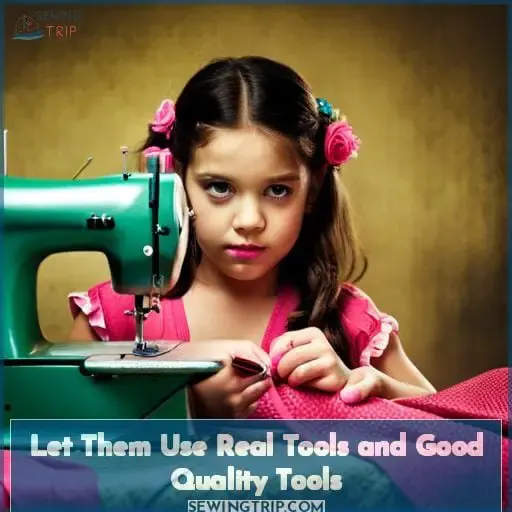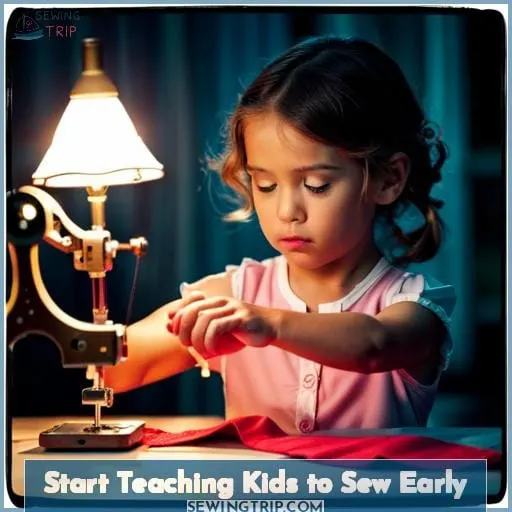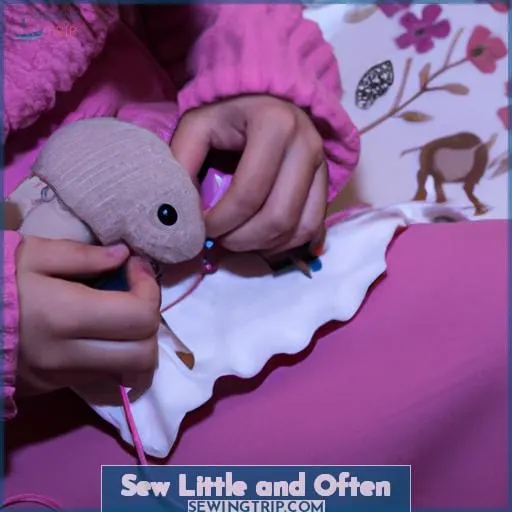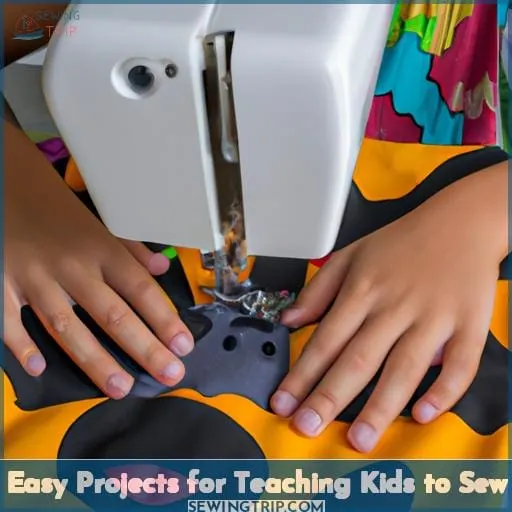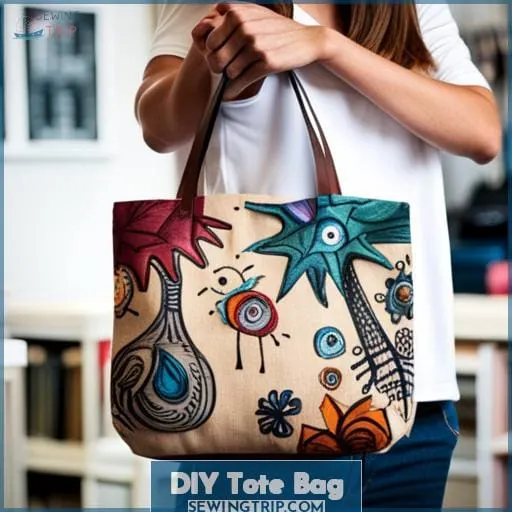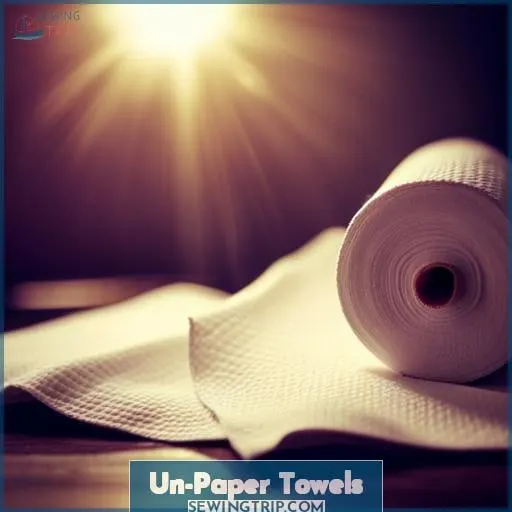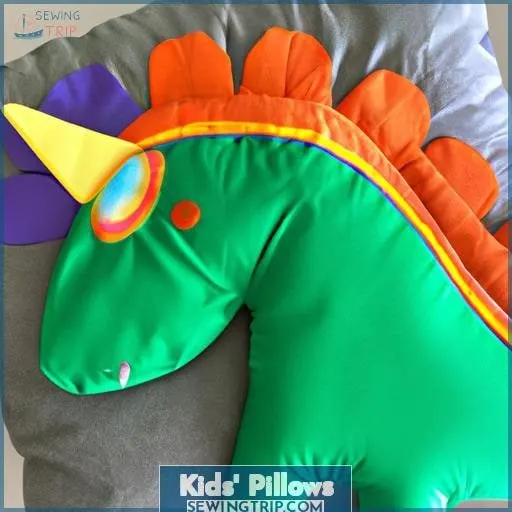This site is supported by our readers. We may earn a commission, at no cost to you, if you purchase through links.
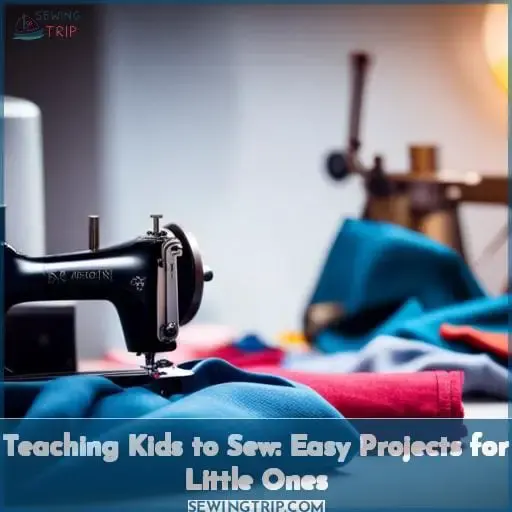 Imagine the joy on your child’s face as they proudly show off their very own sewing project. Teaching kids to sew can be a rewarding and empowering experience for both of you.
Imagine the joy on your child’s face as they proudly show off their very own sewing project. Teaching kids to sew can be a rewarding and empowering experience for both of you.
In this article, we’ll explore easy projects that are perfect for little ones just starting out with sewing. From DIY tote bags to doll skirts, these fun and simple projects will help foster creativity while teaching valuable skills.
Get ready to embark on a sewing adventure with your child!
Table Of Contents
- Key Takeaways
- Let Them Use Real Tools and Good Quality Tools
- Start Teaching Kids to Sew Early
- Sew Little and Often
- It’s Okay if They Only Do Half a Project Themselves
- Once They Get a Taste for It, Let Them Sew
- Easy Projects for Teaching Kids to Sew
- DIY Tote Bag
- Doll Skirt
- Un-Paper Towels
- Kids’ Pillows
- Frequently Asked Questions (FAQs)
- Conclusion
Key Takeaways
- Use real tools and good quality supplies
- Start teaching kids to sew early
- Sew little and often
- Allow kids to do half a project themselves
Let Them Use Real Tools and Good Quality Tools
Use real tools and good quality tools when teaching kids to sew.
It’s important to give them the proper equipment for a safe and successful sewing experience.
Provide sharp needles that are suitable for their age, as well as pointy scissors with rounded tips to prevent accidents.
Using durable fabric will ensure that their projects hold up over time.
By using quality tools, you’re not only ensuring your child’s safety but also teaching them the value of craftsmanship and attention to detail.
They’ll learn how different tools affect the outcome of their work and develop essential skills in machine learning.
Investing in good quality tools sets a foundation for future sewing endeavors, whether it be simple hand sewing projects or more advanced techniques like felt sewing projects or beginner machine stitching.
So remember, choose sharp needles, pointy scissors with rounded tips, durable fabric materials,and high-quality supplies when introducing kids to the world of sewing!
Start Teaching Kids to Sew Early
Now that you know the importance of using real tools and good quality materials, it’s time to delve into the next step: starting to teach kids to sew early.
By introducing sewing at a young age, you can foster their creativity and develop valuable skills that will last a lifetime.
- Safety: When children start sewing at a younger age, they can learn about safety precautions and proper handling of tools under close supervision.
- Supervision: Starting early allows parents or instructors to provide guidance and ensure that children understand the basics of sewing techniques.
- Encouragement: Early exposure helps build confidence in kids as they see their progress over time with simple beginner projects.
- Patience & Creativity: Sewing requires patience, attention to detail, problem-solving skills, and encourages imaginative thinking.
By starting young with beginner sewing projects for kids like felt softies or simple fabric crafts , you lay the foundation for their lifelong love of creating through stitching.
Sew Little and Often
Start sewing with your kids little by little and make it a regular activity that you do together.
Sewing doesn’t have to be overwhelming for beginners, especially when teaching kids.
Use kid-friendly tools and supervise them closely to ensure safety.
Let your kids come up with their own designs or choose from options like lacing cards, felt heart ornaments, or a nature pouch.
These easy sewing projects will help build their confidence and keep them engaged in the process.
By incorporating sewing into your routine regularly, you’ll create lasting memories while nurturing their creativity and practical skills.
It’s Okay if They Only Do Half a Project Themselves
Can kids still learn to sew effectively if they only complete half of a project themselves?
Absolutely! Sewing is about the process, not just the end result. By allowing children to participate in sewing projects even if they only do half of it themselves, you’re giving them valuable opportunities for learning and growth.
Here’s why it’s okay:
- Allow Mistakes: Making mistakes is part of the learning process. Letting kids make their own mistakes and guiding them through problem-solving builds resilience and critical thinking skills.
- Praise Effort: Encourage children by praising their effort rather than focusing solely on perfection or completion. This boosts their confidence and motivates them to continue trying.
- Give Choices: Offer options within a project so that kids can make decisions based on their preferences, fostering independence and creativity.
Once They Get a Taste for It, Let Them Sew
Once your child has experienced the joy of sewing and completed a few projects with your guidance, it’s time to let them take the lead and sew on their own.
It’s important to let them experiment, encourage creativity, make mistakes, have fun, and learn new skills along the way.
Giving children the freedom to explore sewing independently won’t only boost their confidence but also foster a sense of liberation and belonging in their creative endeavors.
Allow them to choose their own projects that spark excitement in them – whether it be making doll clothes or designing tote bags.
Emphasize that there’s no right or wrong way when it comes to sewing; instead, focus on embracing the journey of discovery together as they continue honing their craftmanship through hands-on experience.
So go ahead – unleash your child’s inner seamstress or tailor!
Easy Projects for Teaching Kids to Sew
Now that your little ones have gotten a taste for sewing, it’s time to dive into some easy projects that will keep their creativity flowing and their sewing skills growing. These projects are perfect for teaching kids to sew because they’re fun, engaging, and achievable.
Remember to always prioritize safety by supervising them closely and providing proper tools like fabric scissors. Encourage patience as mistakes may happen along the way but remind them that mistakes only lead to learning opportunities.
Let’s explore some exciting project ideas:
- DIY Tote Bag: Teach your child how to create their own personalized tote bag using colorful fabrics.
- Doll Skirt: Help them design adorable skirts for their favorite dolls or plush toys.
3.Un-Paper Towels: Teach sustainability while creating reusable un-paper towels from fabric scraps.
4.Kids’ Pillows: Guide them in making cute pillows with different shapes and patterns.
With these beginner-friendly projects, you’ll be able to provide a safe environment where your children can learn valuable skills while having heaps of fun!
DIY Tote Bag
Choose a simple and practical DIY tote bag project to teach your kids the art of sewing. A tote bag is a versatile accessory that can be used for carrying books, toys, or even groceries. It’s an excellent beginner project because it involves basic stitching techniques and allows kids to practice cutting fabric with scissors.
To make the process more enjoyable, here’s a table outlining the materials needed:
| Materials |
|---|
| Fabric |
| Scissors |
| Thread |
| Needle |
| Lining |
Start by selecting medium-to-heavyweight cotton fabric such as quilting cotton or cotton canvas for durability. Cut two rectangular pieces of equal size for the body of the bag and one long strip for each strap using scissors.
Next, fold each piece in half lengthwise with right sides facing inward and sew along both side seams using thread and needle.
Finally, attach lining if desired by repeating these steps but leaving an opening on one side seam to turn it right-side out later on.
Now your child has learned how to create their own custom tote bag!
Doll Skirt
To continue our exploration of simple sewing projects for teaching kids, let’s move on to the adorable world of doll skirts.
Doll skirts are a perfect project for little ones who are eager to learn and create something special for their favorite dolls.
There are many tutorials available online that provide step-by-step instructions on how to sew these cute skirts. Your child will have so much fun picking out the fabric and creating unique designs for their dolls.
This tutorial won’t only teach them basic sewing skills but also ignite their creativity as they bring fashion into the miniature world of playtime.
Un-Paper Towels
When teaching kids to sew, one great project to start with is making un-paper towels. These durable, reusable, and washable towels aren’t only practical but also eco-friendly.
Here are three reasons why un-paper towels make a fantastic sewing project for little ones:
- Absorbent: Un-paper towels made from absorbent fabric like cotton or terry cloth can easily replace disposable paper towels in your home.
- Eco-friendly: By using these reusable alternatives, you’re reducing waste and helping the environment.
- Fun customization: Kids can choose their favorite fabrics and patterns to create unique designs that reflect their personality.
Teaching kids how to sew by making un-paper towels not only instills valuable skills but also empowers them with a sense of environmental responsibility. Plus, having these handy cloths around the house ensures safety by eliminating the need for potentially harmful chemicals found in disposable paper products.
Kids’ Pillows
Now let’s move on to making kids’ pillows, a great project for little ones to practice their sewing skills and create something cozy for themselves. When it comes to designing kids’ pillows, the options are endless. You can choose different shapes, sizes, and designs that will appeal to your child’s interests and style preferences.
Here is a simple table outlining the materials you’ll need:
| Material | Description |
|---|---|
| Fabric | Choose soft and durable fabrics like cotton or flannel in fun prints or colors that your child loves. |
| Stuffing | Use polyester fiberfill as it’s affordable and easy to find. |
Once you have gathered these materials, encourage your child to get creative with their pillow design! They can choose animal-shaped pillows or even personalize them with appliques or embroidery stitches.
The key is allowing them freedom of expression while honing their sewing skills.
Frequently Asked Questions (FAQs)
What are some appropriate sewing tools for kids to use?
To keep your little ones safe while sewing, provide them with appropriate tools:
- Child-sized scissors
- Blunt tip needles
- A beginner-friendly sewing machine
These tools will help foster their creativity and build practical skills in a fun and secure environment.
How can I encourage my child to continue sewing after completing a project?
Help your child stay engaged in sewing by:
- Allowing them to choose their own projects, encouraging creativity and independence.
- Providing a variety of project ideas and materials for inspiration, ensuring they feel empowered and motivated to continue their sewing journey.
Are there any safety precautions I should take when teaching kids to sew?
When teaching kids to sew, safety is paramount.
Always supervise children and use real tools of good quality.
Start with basic projects they’ll actually use, like tote bags and doll clothes.
Happy sewing!
What are some age-appropriate sewing projects for beginners?
For beginner sewers, age-appropriate projects include:
- Star pillows
- Soft toys
- Scrunchies
- Doll clothes
- Tote bags
- Zipper pouch pencil cases
Let your child’s imagination run wild as they create their own masterpieces!
How can I involve my child in the process of choosing sewing projects?
Involve your child in choosing sewing projects by considering their interests and what they’ll actually use.
Show them images or examples of the final project to inspire them.
Let their creativity blossom!
Conclusion
To sum it up, teaching kids to sew can be a delightful and empowering experience for both parent and child.
By using real and good quality tools, starting early, and sewing little and often, children can develop valuable skills and unleash their creativity.
Even if they only complete half a project themselves, it’s important to encourage their progress.
Once they get a taste for sewing, there are plenty of easy projects like DIY tote bags, doll skirts, un-paper towels, and kids’ pillows that will keep them engaged and excited about their sewing adventure.
So grab some fabric and thread, and let’s get sewing with the little ones!

